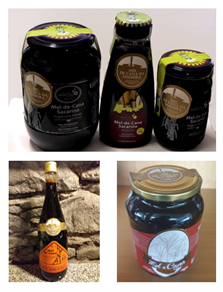Tags: Autonomous region of Madeira • PDO - Protected Designation of Origin (Agricultural products and foodstuffs) • Agrupamento de Produtores do Mel-de-Cana da Madeira
Description: Mel-de-Cana da Madeira is a sugarcane syrup resulting from the purification, refinement, and concentration of natural, unfermented, sugarcane (Saccharum officinarum L.) juice, from traditional varieties that grown on Madeira Island, and is obtained without the addition of any pH regulator, promoter of sucrose inversion, or any sweetener or preservative, natural or artificial, following Madeiran traditional production method.
Normally shows an elevated content in total sugars (greater than 50% and up to 75%), with a sucrose content that varies between 20 and 45 g/100g, a tenor in reducing sugars (fructose and glucose), always greater than 17 g/100g and that can exceed 20 g/100g, and an ash purport greater than 3.5% (and less than 5.5%).
Normally shows an elevated content in total sugars (greater than 50% and up to 75%), with a sucrose content that varies between 20 and 45 g/100g, a tenor in reducing sugars (fructose and glucose), always greater than 17 g/100g and that can exceed 20 g/100g, and an ash purport greater than 3.5% (and less than 5.5%).
Is distinguished by its dark colour, that ranges from brown almost black, to a dark brown, slightly golden or amber, with orange to golden hues when in a thin layer. Can be opaque and very homogeneous or slightly translucent and brighter and be quite clear or contain very small bubbles or light particles. Can have a homogeneous texture, very creamy, velvety, and light, which liquefies quickly at mouth, with a medium/high viscosity, which makes it thick, but with a lot of fluidity and a light and caramelized consistency with tiny particles that we can feel.
It has a sweet, caramelized and very characteristic aroma and flavour, with vegetable (fresh ground sugarcane), fruity (sultanas) or metallic notes, and hints of vanilla, spices or bake. With little to some astringency, a soft bitterness and a pleasant acidity, at the end of mouth taste, which give it balance. Overall, it has a harmonious, homogeneous, frank, and balanced aroma and flavour, with medium to high intensity and persistence.
It has a sweet, caramelized and very characteristic aroma and flavour, with vegetable (fresh ground sugarcane), fruity (sultanas) or metallic notes, and hints of vanilla, spices or bake. With little to some astringency, a soft bitterness and a pleasant acidity, at the end of mouth taste, which give it balance. Overall, it has a harmonious, homogeneous, frank, and balanced aroma and flavour, with medium to high intensity and persistence.
Production method: The main and unique raw material on Mel-de-Cana da Madeira production, are sugarcane stalks, from traditional varieties: “Rajada”; “Violeta”, “Canica”; “Roxa” and “Amarela” or “Branca”, obtained on Madeira Island.
Its traditional producing method remain constant, at least, since the first decades of the 19th century. So, the three “Engenhos” (sugarcane transformation units) that currently ensure this production, resort to secular technologies and equipment, more or less, modern, that fully respects its typical operations of:
Its traditional producing method remain constant, at least, since the first decades of the 19th century. So, the three “Engenhos” (sugarcane transformation units) that currently ensure this production, resort to secular technologies and equipment, more or less, modern, that fully respects its typical operations of:
- Purification or cleaning: by decantation and/or filtration, of the unfermented sugarcane juice, resulting from the crushing of stalks of traditional varieties sugarcane, locally produced;
- Thermal clarification or refinement: made without the addition of any chemical product, to provoke the agglutination and removal of impurities present on the sugarcane juice. The characteristics of clarifiers tanks used determine the duration of this operation, that can take from 30 minutes to 3 hours, and also temperatures reached (be-tween 60º C and 80º C);
- Purification of “caldo de cana” (sugarcane broth): by decantation or filtration, to separate “lees”, from any suspended materials that have not been flocculated and removed from “caldo de cana” before boiling;
- Evaporation of “caldo de cana”: through a cooking process, with a gradual increase of temperature till exceeds its boiling point. The type of evaporation tanks, determines the time that the high temperatures (between 100 ºC and 108 ºC) must be maintained (from 10 to 13 hours, to more than 24 hours) to the refinement and concentration of the constituents of “caldo de cana”, by the releasing of steam and the caramelization of its sugars, until obtaining a sugarcane syrup with the typical density (38º - 40º Baumé) of this product;
- Stabilization of Mel-de-Cana da Madeira: on storage tanks, where it can cool and settles, and be conserved till be sent to the “filling tank” for packaging;
- Packaging: carried out manually, by taps at the bottom of the “filling tank”, that allow its direct pouring to glass jars, plastics packag-ing or to other appropriate containers, of different capacities, used in its pre-packaged or bulk marketing.
Special features: Mel-de-Cana da Madeira is a syrup rich in soluble sugars, very stable and normally free from crystallization, obtained following the Madeira traditional process of transformation, developed at home level, and later, adapted to the Engenhos production, and that due to the intrinsic characteristics of sugarcane juice from traditional varieties of Madeira Island, does not need the addition of any pH regulator or sucrose inversion promoter, nor any natural sweetener or preservative. or artificial.
It shows a slightly acidic pH, high ash levels and a high content of reducing sugars, which are responsible for its stability and for its peculiar sensory characteristics, in particular its intense and dark colour and, above all, its sweet and caramelized aroma and flavour. with a soft bitterness and a pleasant acidity, with vegetable, fruity or metallic notes, and hints of spices or roast.
In addition on being consumed as such to spread on bread or to sweeten fried delicacies (malassadas, dreams and French toast) and even to enrich local cuisine, Mel-de-cana da Madeira, correspond the essential ingredient in many of the main traditional sweets, linked to Madeiran Christmas and Carnival festivities, and together with Rum da Madeira IGP, represents the heirs of the important sugarcane processing industry that thrived on this island and that branded the history, culture and gastronomy of Madeirans.
It shows a slightly acidic pH, high ash levels and a high content of reducing sugars, which are responsible for its stability and for its peculiar sensory characteristics, in particular its intense and dark colour and, above all, its sweet and caramelized aroma and flavour. with a soft bitterness and a pleasant acidity, with vegetable, fruity or metallic notes, and hints of spices or roast.
In addition on being consumed as such to spread on bread or to sweeten fried delicacies (malassadas, dreams and French toast) and even to enrich local cuisine, Mel-de-cana da Madeira, correspond the essential ingredient in many of the main traditional sweets, linked to Madeiran Christmas and Carnival festivities, and together with Rum da Madeira IGP, represents the heirs of the important sugarcane processing industry that thrived on this island and that branded the history, culture and gastronomy of Madeirans.
Production area: Madeira Island
History: Since the beginning of the settlement of this island, its mild climate, wealth in water and in luxuriant vegetation that generates good woods (which gave it its name) and the good quality of the soils formed by the clearing and cleaning of the stream beds, quickly made first portuguese settlers self-sufficient on cereals and others introduced crops. So, around 1425, Infante D. Henrique (Lord of the Islands) ordered “stakes” of sugarcane from Sicily to start this production on Madeira.
The installation of sugarcane plantations required the creation of new “agricultural soils”, from fires at the high and wooded areas of the island and, overall, from the general construc-tion of terraces, locally called “poios”, which follow the contour lines and are supported by walls of basalt stone. It was also need the construction of an extensive network of irrigation channels (“levadas”) to transport water from streams and springs and, later, also from the highlands and the humid slope to the north, to ensure the irrigation of the cane fields, providing sugarcane with the ideal soil and climate conditions for its adaptation and development.
Also, the availability of water courses, of wood and cattle for the movement of loads and mills, contributed to the improvement of the rudimentary techniques of cane milling and the crystallization processes for production of sugar, that, at Middle Ages, was considered a highly valued and “luxury product”, whose consump-tion was reserved to courts and wealthier classes. In a few decades, Madeiran sugar masters and merchants, monopolized the supply of sugar to the Kingdom and to main European courts, generating a relevant commercial activity that, until the end of the 16th century, boosted the island's first economic cycle of development.
Historical records shows that syrups production, called «Mel», always accompanied the famous “sugar” production. Initially it corresponded to the syrup that flowed from the forms of sugar production (“pães de açúcar”) in the successive purges of its crystallization process. This product was very wanted for vessels that called the port of Funchal, in the first half of the 16th century, as is reported by the Memorial of Christopher Columbus to the Catholic Kings, in January 1494, which recommends the shipment of 50 barrels of «Mel» from Madeira for his crews use.
At that time, also some sugarcane plantation owners promoted homemade production of «Mel», but, in this case, from the cooking of whole sugarcane juice from their harvest, which they reserved for family consumption and the production of fruit preserves, especially in some local convents, where this «Mel», was also used in the recipes of cakes and various sweets, that were produced, on religious events (Advent, Christmas or Carnaval), for internal consumption, offering to benefactors and even for exportation.
Even during the decline of this culture on the island (between the 17th and 19th centuries), this homemade production of «Mel», remained active, keeping some small sugarcane plantations and preserving the rich Madeira convent sweets production.
From the 19th century onwards, the reintroduction on the island of new cultivated forms of sugarcane, the production of «MEL» started to be carried out, at industrial level, simultaneously, although on a smaller scale, with production of others sugarcane derivatives. that were successively obtained on the island: sugar, alcohol (to enrich Vinho Madeira) and, more recently, Madeira Rum, a spirit drink registered as a Protected Geographical Indication.
All historical records that refer or describe this sugarcane syrup, call it «Mel» and even «Mel da Madeira», designations that remained in use on the island and in Portugal, for almost six centuries until, at the end of the 20th century, by European legislation, the designation «Mel», which also means «Honey», became exclusively reserved for the natural sugary substance produced by bees of Apis mellifera species, so that Madeira producers had to adopt the name Mel-de-cana da Madeira, to designate this product of great local economic interest and high significance for the identity and collective memory of the Madeiran population.
Product specification (pdf)
Producer group
Agrupamento de Produtores do Mel-de-Cana da Madeira
Agrupamento de Produtores do Mel-de-Cana da Madeira
Control and certification body
CTAC-RAM - Comissão Técnica de Avaliação da Conformidade dos Produtos Agrícolas e dos Géneros Alimentícios da Região Autónoma da Madeira
CTAC-RAM - Comissão Técnica de Avaliação da Conformidade dos Produtos Agrícolas e dos Géneros Alimentícios da Região Autónoma da Madeira
Publication in EU official journal
----
----
Publication in the Portuguese official journal
----



